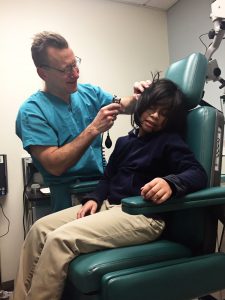FAQs
Frequently Asked Questions about pediatric cochlear implantation at UNC
A cochlear implant is a surgically implanted electronic device that provides a sense of sound to a person who is severely hard of hearing or profoundly deaf.
The U.S. Food and Drug Administration (FDA) first approved cochlear implant devices for adults in 1985 and for children in 1990.
Adults and children who meet the criteria approved by the FDA, and are medically healthy for surgery, are candidates for a cochlear implant.
Cochlear implant surgery takes 2 to 3 hours under general anesthesia [an-uhs-thee-zhuh]. Most patients are discharged the same day as operation. An incision is made behind the ear and a section is made in the bone to secure the implant package and to protect it. Once the mastoid bone is opened, the electrode array is placed into the cochlea. Please refer to the pre-surgery & post-surgery section of this handbook for further information.
No. A cochlear implant provides the sense of sound to the hearing system by electrically stimulating the remaining neural elements in the cochlea. A patient will need to learn to listen to these new sounds. Working with an audiologist, speech-language pathologist, early interventionist, or teacher of the hearing-impaired will help the child identify sounds and improve auditory skills. Therapy and training that focuses on listening can help the child speak more clearly. Speech and language develops with time and experience.
The vast majority of patients at our center who receive cochlear implants use them successfully. However, there is a wide range of outcomes. These outcomes will be discussed with you during the evaluation process.
Usually, the transmitter and receiver contain magnets, which attract each other to stay aligned.
No. A cochlear implant provides the sense of sound to the hearing system by electrically stimulating the remaining neural elements in the cochlea. A patient will need to learn to listen to these new sounds. Working with an audiologist, speech-language pathologist, early interventionist, or teacher of the hearing-impaired will help the child identify sounds and improve auditory skills. Therapy and training that focuses on listening can help the child speak more clearly. Speech and language develops with time and experience.
Yes, re-implantation is almost always possible. It may take time for the child to return to his or her previous level of hearing. With time, hearing outcomes after re-implantation have been reported to be as good as or better than the previous device. An older implant is never removed/replaced if it is still working unless there is a decline in performance. The CI manufacturers release new outside equipment every 5 years or so. If it is not immediately compatible with your implant, the manufacturer will work to make it compatible within a few years.
Yes. The processor should be removed at night to let the scalp rest and to charge the processor’s batteries. The processor should be stored in a Dry-N-Store to remove moisture.
Probably. Most implants are durable enough to wear while playing sports. Some devices are waterproof so you may use them in the water. Ask your audiologist if the device chosen may be used in water. Deep water diving may harm the internal implant due to the high water pressure.
The use of FM or other assistive listening devices such as the Roger system should be made on a case by case basis.
Collapse All
